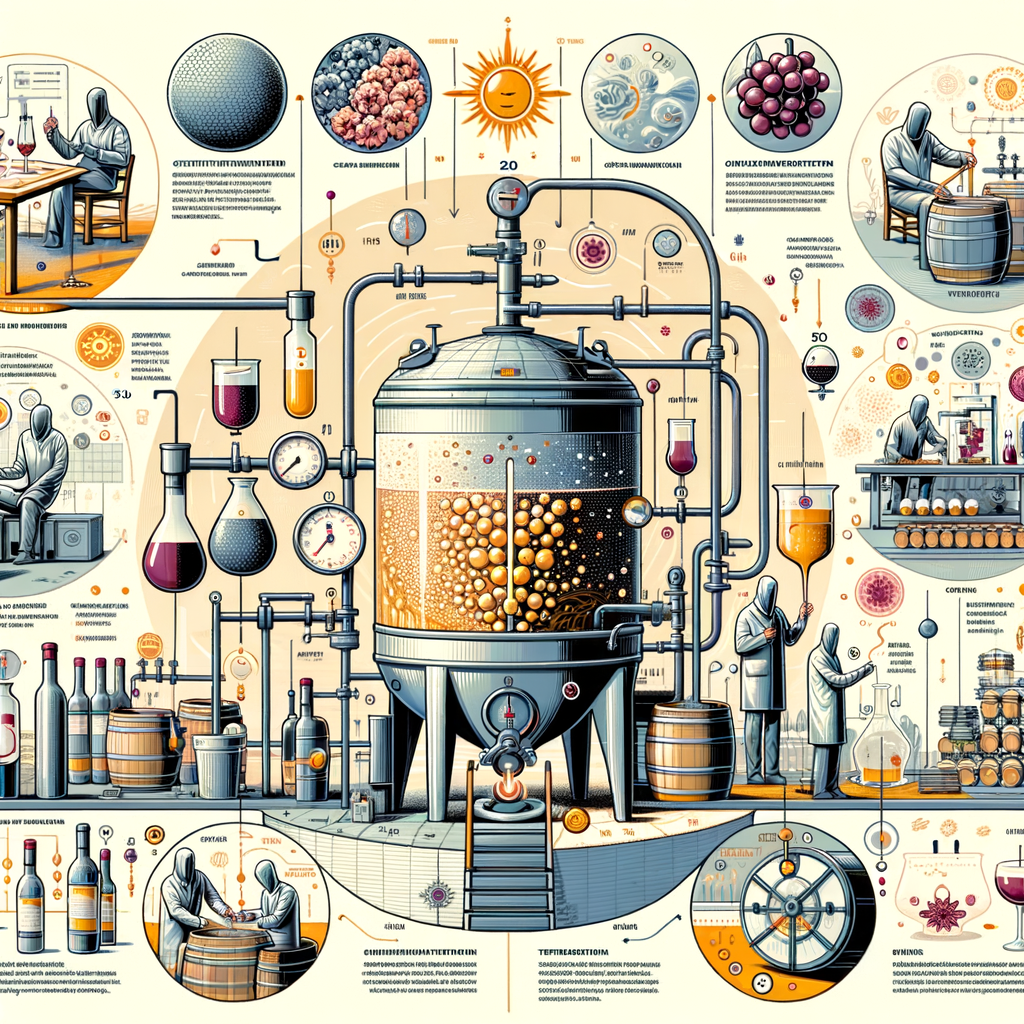
The Art and Science of Wine Making
Wine making is a fascinating process that combines both art and science. It involves the careful selection of grapes, the meticulous process of fermentation, and the delicate art of blending. Let’s delve into the intricate world of wine making.
-
- Introduction to the Wine Making Process
The process of wine making begins with the harvest of grapes. The grapes are then crushed and their juice is collected. This juice is then fermented by adding yeast, which consumes the sugar in the juice and converts it into alcohol. After fermentation, the wine is aged in barrels to develop its flavors before it is finally bottled.
-
- The Science behind Wine Making
The science of wine making is all about understanding the chemistry of grapes and the biology of fermentation. Grapes contain sugars, acids, and tannins, which all play a crucial role in the taste of the final product. The yeast used in fermentation is a living organism that consumes the sugar in the grape juice and produces alcohol, carbon dioxide, and heat. This process is known as fermentation. The art of wine making lies in controlling this process to produce a wine with the desired taste and aroma.
-
- The Artistic Aspect of Wine Making
The art of wine making involves the careful blending of different grape varieties to create a unique flavor profile. It also involves the choice of when to harvest the grapes, how long to ferment the juice, and how long to age the wine. These decisions are often based on the winemaker’s experience and intuition, as well as the specific characteristics of the grape variety and the conditions of the growing season.
Wine making is both an art and a science. It involves a deep understanding of the biology and chemistry involved in the fermentation process, as well as a creative touch in blending different grape varieties to create a unique and enjoyable product. Whether you’re a wine enthusiast or a casual drinker, understanding the process behind wine making can enhance your appreciation of this delightful beverage.
| Wine Making Process | Description |
|---|---|
| Harvesting | The process of picking ripe grapes from the vine. |
| Fermentation | The process where yeast consumes sugar in the grape juice and converts it into alcohol. |
| Aging | The process where the wine develops its flavors in barrels before it is bottled. |
The Impact of Temperature on Wine Making
Temperature plays a crucial role in the process of wine making. It influences the taste, aroma, and overall quality of the wine. In this section, we will explore the role of temperature in wine making, how it influences the process, and a case study of wine production in different climates.
-
- Overview of the Role of Temperature in Wine Making
Temperature is one of the most important factors in wine making. It affects every stage of the process, from the growth of the grapes to the fermentation of the juice. In the vineyard, the temperature can influence the ripeness and flavor of the grapes. During fermentation, the temperature can affect the speed of the process and the flavors produced. A controlled temperature ensures that the wine develops the desired characteristics.
-
- How Temperature Influences the Wine Making Process
The temperature during the fermentation process is particularly important. If the temperature is too high, the yeast can become too active, leading to a faster fermentation process. This can result in a wine with high alcohol content and less flavor. On the other hand, if the temperature is too low, the fermentation process can be too slow or even stop, leading to a wine that is too sweet or has an off flavor. Therefore, maintaining the right temperature is crucial for producing a high-quality wine.
-
- Case Study: Wine Production in Different Climates
Let’s take a look at two different wine regions: Napa Valley in California and Bordeaux in France. Napa Valley has a warm climate, which leads to ripe, fruity wines with high alcohol content. Bordeaux, on the other hand, has a cooler climate. This results in wines that are more balanced, with lower alcohol content and higher acidity. This case study shows how the climate and temperature can influence the characteristics of the wine.
Temperature plays a vital role in wine making. It influences the growth of the grapes, the fermentation process, and the final characteristics of the wine. By understanding the impact of temperature on wine making, we can appreciate the art and science behind each bottle of wine.
Understanding Wine Production Techniques
Wine production is a fascinating process that combines both art and science. It involves a series of steps that transform simple grapes into the delicious wine we enjoy. In this section, we will delve into the different techniques used in wine production, from traditional methods to modern innovations, and the role of temperature control in these techniques.
-
Traditional Wine Production Techniques
Traditional wine production techniques have been passed down through generations of winemakers. They typically involve manual labor and rely heavily on the natural environment and the winemaker’s intuition. The grapes are usually hand-picked and then crushed using a wine press. The juice is then fermented in large wooden barrels, where it transforms into wine through the natural process of yeast converting the sugars in the grapes into alcohol. This process can take several weeks to months.
-
Modern Innovations in Wine Production
With advancements in technology, modern innovations have been introduced to the wine production process. These include mechanical harvesting, which allows for a more efficient collection of grapes, and stainless steel fermentation tanks, which provide better temperature control. Additionally, modern winemakers have access to a variety of yeasts that can influence the flavor, aroma, and other characteristics of the wine. These innovations have allowed for more consistency and control in the wine production process.
-
The Role of Temperature Control in Wine Production Techniques
Temperature control plays a crucial role in wine production. During fermentation, the temperature can greatly affect the speed of the process and the quality of the wine produced. Too high temperatures can lead to rapid fermentation and potentially spoil the wine, while too low temperatures can slow down the fermentation process. Modern innovations, such as stainless steel tanks, have allowed winemakers to better control the temperature during fermentation, leading to more consistent and high-quality wines.
Wine production is a complex process that involves a blend of traditional techniques and modern innovations. Understanding these techniques can enhance our appreciation of the art and science behind every bottle of wine.
Exploring Cold Fermentation in Wine Making
Wine making is an art that has been perfected over centuries. One of the techniques that has gained popularity in recent times is cold fermentation. Let’s delve into what it is, its benefits, and some examples of wines produced using this method.
-
- What is Cold Fermentation?
Cold fermentation is a wine making process where the fermentation of the grape juice is carried out at lower temperatures, typically between 45°F and 60°F. This technique is often used in the production of white and rosé wines, though it can also be used for reds. The low temperature slows down the fermentation process, allowing the wine to retain more of its natural fruit flavors and aromas.
-
- The Benefits of Cold Fermentation in Wine Making
There are several benefits to using cold fermentation in wine making. First, it helps to preserve the delicate fruit flavors and aromas in the wine, resulting in a more aromatic and flavorful end product. Second, it can help to reduce the risk of unwanted bacterial growth during fermentation, as the cooler temperatures inhibit their development. Lastly, cold fermentation can result in a wine with a smoother, more balanced acidity, enhancing its overall taste and quality.
| Benefits | Description |
|---|---|
| Preserves flavors and aromas | Helps to retain the natural fruit flavors and aromas of the grapes. |
| Reduces bacterial growth | Lower temperatures inhibit the development of unwanted bacteria during fermentation. |
| Improves acidity balance | Results in a wine with a smoother, more balanced acidity. |
-
- Examples of Wines Produced Using Cold Fermentation
Many popular wines are produced using the cold fermentation process. Some examples include Sauvignon Blanc, Chardonnay, and Pinot Grigio. These wines are known for their crisp, fresh flavors and aromatic profiles, which are enhanced by the cold fermentation process. For instance, a Sauvignon Blanc produced using cold fermentation might exhibit vibrant citrus and green apple notes, while a Chardonnay might showcase rich pear and apple flavors with a hint of vanilla.
Factors Influencing Wine Quality
Among the many factors that influence the quality of wine, the role of climate is paramount. Let’s delve into how climate impacts the wine-making process.
Role of Climate in Wine Making
Climate plays a significant role in the wine-making process. It not only influences the quality of grapes but also affects the fermentation process. Let’s explore these aspects in detail.
-
- How Climate Influences the Quality of Grapes
The climate where the grapes are grown greatly affects the quality of the wine. For instance, grapes grown in cooler climates tend to have higher acidity and lower sugar levels, leading to wines with lighter body and higher acidity. On the other hand, grapes from warmer climates usually have lower acidity and higher sugar levels, resulting in fuller-bodied wines with higher alcohol content.
-
- Climate’s Impact on the Fermentation Process
Climate also plays a crucial role in the fermentation process. In warmer climates, fermentation can occur too quickly, which may lead to a loss of flavor and aroma compounds. Conversely, in cooler climates, fermentation may be too slow or may not complete, leading to wines with residual sugar and lower alcohol content. Therefore, winemakers must carefully manage the fermentation process to ensure the production of high-quality wines.
The climate in which grapes are grown and the wine is fermented plays a significant role in determining the quality of the wine. By understanding these factors, winemakers can better control the wine-making process and produce wines of superior quality.
Wine Making Temperature Control
Temperature control is a critical aspect of wine making. It can influence the taste, aroma, and overall quality of the wine. Let’s delve into the methods for controlling temperature during wine making and the impact of temperature control on wine quality.
- Methods for Controlling Temperature during Wine Making
There are several methods used by winemakers to control the temperature during the wine making process. Let’s look at some of the most common ones:
- Cool Fermentation: This method involves fermenting the wine at lower temperatures, typically between 12-18°C (54-64°F). It helps to preserve the fruity and floral aromas in the wine.
- Temperature-Controlled Stainless Steel Tanks: Many wineries use temperature-controlled stainless steel tanks for fermentation. These tanks allow winemakers to precisely control the temperature during the fermentation process.
- Insulated Fermentation Vats: Some winemakers use insulated fermentation vats to maintain a consistent temperature. The insulation helps to prevent temperature fluctuations that can affect the fermentation process.
- Impact of Temperature Control on Wine Quality
Temperature control plays a significant role in determining the quality of wine. Here’s how:
- Flavor Profile: The temperature at which wine is fermented can significantly affect its flavor profile. For instance, cooler temperatures tend to preserve the fruity and floral flavors, while warmer temperatures can bring out more complex flavors.
- Color: The fermentation temperature can also affect the color of the wine. Red wines fermented at higher temperatures tend to have a deeper color, while those fermented at lower temperatures may have a lighter color.
- Aroma: The aroma of wine is also influenced by the fermentation temperature. Wines fermented at lower temperatures tend to have more delicate and fruity aromas, while those fermented at higher temperatures can have more robust and complex aromas.
Temperature control is a vital aspect of wine making. It can significantly influence the flavor, color, and aroma of the wine, ultimately determining its quality. Therefore, winemakers must carefully control the temperature during the wine making process to produce high-quality wines.
Wine Fermentation Temperature: A Deep Dive
Temperature plays a pivotal role in the process of wine fermentation. It’s like the conductor of an orchestra, guiding and influencing every aspect of the performance. In the case of wine, temperature can significantly affect the taste, aroma, and overall quality of the final product. Let’s dive deeper into this fascinating topic.
-
- Understanding the Importance of Fermentation Temperature
Fermentation is a crucial stage in winemaking. It’s when yeast consumes the sugar in the grape juice and transforms it into alcohol. The temperature at which this process occurs can greatly influence the speed of fermentation, the health of the yeast, and the flavors and aromas produced.
For instance, a high temperature may speed up fermentation, but it can also lead to the death of yeast cells and the production of unwanted flavors. On the other hand, a low temperature may slow down fermentation, preserving delicate flavors and aromas but potentially leading to a stuck fermentation if it’s too cold.
-
- Optimal Temperatures for Different Types of Wine
Different types of wine require different fermentation temperatures. Here’s a simple guide:
| Wine Type | Optimal Fermentation Temperature (°F) |
|---|---|
| White Wine | 50-60 |
| Red Wine | 68-86 |
| Rosé Wine | 55-65 |
These temperatures are not set in stone and can vary depending on the specific grape variety and the desired style of wine. However, they provide a good starting point for understanding the role of temperature in wine fermentation.
-
- Case Study: The Impact of Fermentation Temperature on Wine Flavor
Let’s consider a real-world example to illustrate the impact of fermentation temperature on wine flavor. In a recent study, two batches of Chardonnay were fermented at different temperatures: one at 50°F and the other at 68°F.
The wine fermented at the lower temperature was described as having fresh, fruity, and floral aromas, while the wine fermented at the higher temperature had more tropical, ripe fruit, and buttery notes. This example clearly shows how fermentation temperature can shape the flavor profile of a wine.
The temperature at which wine is fermented is a key factor in determining its final taste and quality. By understanding and controlling this variable, winemakers can craft wines with a wide range of flavors and styles, catering to the diverse tastes of wine lovers around the world.
The Intersection of Art and Science in Wine Making
In the world of wine making, art and science coexist in a beautiful harmony. The artistry lies in the selection of grapes, the careful nurturing of the vineyard, and the precise timing of the harvest. The science, on the other hand, is evident in the rigorous control of fermentation temperatures, the understanding of the chemical reactions involved, and the application of modern production techniques. This delicate balance between art and science is what makes wine making such a fascinating field.
-
- Recap of the Influence of Temperature on the Art of Wine Making
Temperature plays a pivotal role in the wine making process. It influences everything from the ripening of the grapes to the rate of fermentation. As we’ve discussed, maintaining the right temperature during fermentation is crucial for developing the desired flavors and aromas in the wine. Too high temperatures can lead to rapid fermentation and loss of delicate flavors, while too low temperatures can slow down the fermentation process and potentially lead to spoilage. It’s a delicate balancing act that requires both scientific understanding and artistic intuition.
-
- Key Takeaways for Aspiring Winemakers
For those of you who are aspiring to become winemakers, wine making is both an art and a science. It requires a deep understanding of the science behind the fermentation process, as well as a keen artistic sense to create a wine that is unique and pleasing to the palate. Here are some key takeaways:
-
- Understand the science: Learn about the fermentation process, the role of yeast, and the impact of temperature on wine making.
- Master the art: Develop your palate, learn to appreciate different flavors and aromas, and experiment with different grape varieties and fermentation techniques.
- Keep learning: Wine making is a field where there’s always something new to learn. Stay updated with the latest research and trends in the industry.
Wine making is a fascinating blend of art and science. It’s a field where creativity and technical knowledge go hand in hand. Whether you’re a wine lover or an aspiring winemaker, understanding this intersection can deepen your appreciation for this timeless beverage and inspire you to explore new horizons in the world of wine.




